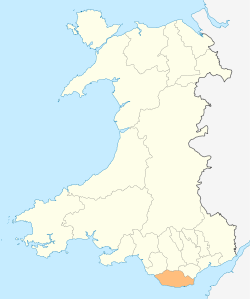The Bendricks
The Bendricks is a stretch of coastline and an important paleontological site in the Vale of Glamorgan in south Wales located along the northern coast of the Bristol Channel between Barry and Sully at 51°23′47″N 03°14′42″W / 51.39639°N 3.24500°W . It lies at the foreshore of the industrial port of Barry between the eastern breakwater of the Barry docks entrance on its western edge to Hayes Point on its eastern edge. This area of the coast is a SSSI.
Geology and topography
A promontory of Carboniferous Limestone rock known as Bendrick Rock juts out from the mainland which is completely submerged at the highest spring tide although during a normal tidal period the top of the rock is still visible at high tide. The geology of the Bendricks consists primarily of Keuper Marls and conglomerate formed primarily by deposition of silt at the shoreline of a shallow muddy sea during the Early Triassic and Late Triassic periods.
The man-made estuary of the Cadoxton River now enters the Bristol Channel at this point having been redirected during the construction of Barry Docks by the Barry Railway Company which began in 1884. Inland of the Bendricks are HMS Cambria [1] [2] and the former Sully Hospital [3]
Dinosaur footprints
The Bendricks is famous for the discovery of dinosaur footprints some of which have been removed to the National Museum and Galleries of Wales in Cardiff[4][5] The BBC featured these footprints and the geology of the Bendricks in its TV series[6] about the Natural History of Wales.
Visiting
The Bendricks can be accessed via a path which follows the outside of the security fence round HMS Cambria at Hayes Point, Sully or by following the coastal path in an easterly direction from the public slipway at the Vale of Glamorgan recycling centre at Hayes Road, Sully.
The footprints can be difficult to see. Many are covered at high tide so it is easier to see them after high tide when the tracks may retain small puddles of water. It is also easier to spot the footprints when the sun is low in the sky as longer shadows will help throw the footprints into relief.[7]
There is a small residential street known as Bendrick Road, consisting of around 50 houses.
References
- ↑ News : HMS Cambria (Cardiff) : Training Centres : Royal Naval Reserve : Operations and Support : Royal Navy
- ↑ http://www.royalnavy.mod.uk/The-Fleet/Maritime-Reserves/Royal-Naval-Reserve/RNR-Units/Cardiff-HMS-Cambria
- ↑ Archives Network Wales - Sully Hospital records
- ↑ 'Where dinosaurs walked' a schools service paper by the National Museum of Wales
- ↑ A.J. Thomas 'Triassic Rocks of the Bendricks'. NMW MSS paper No. 1750.
- ↑ BBC - South East Wales Walks - Dinosaur Footprints at Bendrick Rock, Sully
- ↑ Dinosaur footprints - The Bendricks, Glamorgan, Wales, UK
